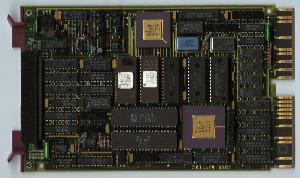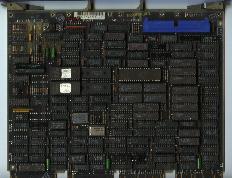The RQDX MFM disk controllers


RQDX controllers are a design dating back to 1983. They could run the then appearing MFM hard disk drives which were cheaper than the other hard disk systems of those days. They are Q-bus cards that communicate with the MicroPDP or MicroVAX using the MSCP protocol.
They were introduced as part of the MicroPDP-11 systems and for 1983 were lightyears ahead of the really pokey Xybec controllers on PCs that could barely manage 90k bytes/sec. The RQDX3 was introduced around '86-87 and was starting to show its limits but was a cost/size reduction while remaining backward compatability. It was still the best choice for cheap and reliable storage.
Think of where 1986 was... IDE was still an infant. SCSI/integrated controller drives weren't quite there and would be expensive as all new technologies are in their early years. ESDI was not yet, SMD and other high end technologies were either BIG, new or EXPENSIVE.
The RQDX controllers are:
M8639 or M8639-YA RQDX1 Q Winchester disk controller, DMA
RX50, RD50, RD51, RD52.
M8639-YB RQDX2 Q Winchester disk controller, DMA
RX50, RD50, RD51, RD52, RD53.
M7555 RQDX3-AA Q Controller and cables for
RX50/RX33/RD50-54/RD31/RD32
RQDXE-AA Q Disk drive bus extender for use
with RQDX2/3
The RQDX3 logic supports a "maximum" MFM drive configuration of 16 data heads and 2048 cylinders, with 17 sectors per track, which works out to 280+ MB in a single unit.
At the time it was introduced, DEC's technical literature made a point of saying that the RQDX3 could support new drives without firmware revisions because the drive geometry was written to the disk at format time, rather than being stored in controller firmware -- which _was_ the case for the RQDX1 and RQDX2. (RQDX1 and 2 are the same board with different firmware. The later RQDX2 has knowledge of RD50-53 where the RQDX1 only knows the RD50-52.) This also means the disks are formatted differently for the RQDX3 than the RQDX1-2. You cannot move a drive from a RQDX1-2 to a RQDX3 without a reformat.
Follow this link for scans of the RQDX manual
RD drive equivalents
RQDX1 ST506(RD50), st412(RD51), st225(RD31), D540(rd52) RQDX2 ST506(RD50), st412(RD51), st225(RD31), D540(rd52), M1325(RD53) RQDX3 ST506(RD50), st412(RD51), st225(RD31), D540(rd52), M1325(RD53-71MB), Maxtor2190(RD54-159MB)
Additional information on the RQDX3
W12..W17
These set the starting "logical unit number" for the board, as a binary number (W12=LSB, W17+MSB). If you have multiple RQDXn boards, you'd typically set the second card to start with LUN 4, the third with LUN 8, etc. Jumper out = 0, jumper in = 1.
W23
Controls the HEADSEL 3 and REDUCWRTI signals. W23 has 4 posts numbered 1..4. Factory setting is 1-2 jumpered on early firmware, 1-2 and 3-4 for version 2 firmware (ROMs 23-243E5/23-244E5) or later. Alternatively, you can jumper 2-3, which has the effect of connecting HEADSEL 3 to pin 9 of J1, and REDUCWRTI to pin 22. That allows you to use hard drives with more than 8 heads.
W1-W11
The RQDX3 has Address Jumpers W1 through W11 corresponding to the CSR Address bits A2 through A12. The factory default is 17772150 jumpered as W11, W9, W5, W4, and W2 Installed. All other CSR address jumpers should be out. Pins 1 & 2 of W23 should be jumped if you are using an RD54, Otherwise loss of format may occur.
For the RD5x drive select jumpers, they should be set to select drive 3.

